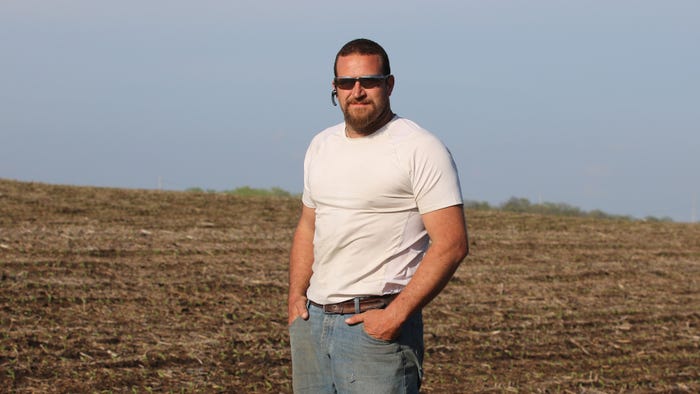May 10, 2024

YIELDS: Alex Noll, Jefferson County, Kan., says micromanaging inputs for his corn crop at planting leads to big yields at harvest.Photos by Laura Handke
by Laura Handke
When fourth-generation Jefferson County farmer Alex Noll won the first National Corn Growers Association yield contest he entered with an entry of 259 verified non-irrigated bushels per acre, he thought he had reached his peak.
“I didn’t think I would live long enough to beat 259, and I definitely didn’t think I would gain almost 50 bushels an acre in a decade,” Noll says, adding that he would go on to win another nine yield contests with the NCGA.
The progressive farmer, who grew his family’s farming operation from 900 acres in 2003 to the more than 4,000 acres he will plant this season, shares his #Plant24 insights and opens up about the micromanagement and peer-to-peer education he credits his high-yield success to in this #Grow24 follow-along.
Preseason game plan
“Next year’s harvest starts when we put the combine in the shed,” Noll says. “We used to say that harvest started when we pulled the planter out of the shed, but there’s a lot we can do to capture yield potential during the fall prior to planting.”
Noll says that in the five northeast Kansas counties he farms, drought is always on his mind; because of that, he sets his soil up to weather dry conditions. With the help of a friend, Noll fabricated a single-tooth ripper, and today, the tree border of every field is ripped each fall.
“It’s staggering — the bushels you can put on by the outer edges, and when you add that gain to the largest area of any field, it makes a big difference in your yield average,” he says.
Noll also employs a 1.1-acre grid-sampling program with a complete analysis and full baseline saturation every four years.
By January, Noll is in possession of every seed that will be planted for the season, a management choice he says saves time, “It’s not uncommon for me to load soybean seed at 2 or 3 in the morning. I’m not having to give up daylight hours to pick up seed when businesses are open.”
#Plant24
Noll finds success in corn-on-corn acres, micromanaging his inputs, hybrid varieties, and management plan to negate the yield drag that is often attributed to the farming practice.
“As farmers, we always hear a lot about rotation, but I disagree with that to some extent. Continuous corn just requires different management, and the challenges of the practice are not difficult to overcome,” he says.
Last year, Noll strayed from corn-on-corn because of high nitrogen prices. Instead, he sowed what he calls a “large beta test” of soft wheat followed by double-crop soybeans. The strong Kansas City wheat market and performance of the later-planted beans convinced Noll to double his wheat-bean acres this year. Noll adds that his double-crop beans yielded what his early-planted beans did in the previous year. He attributes the trend to the Labor Day heat and sunshine northeast Kansas has experienced for the past several years, along with the hot and dry conditions of late-July that rob bushels from the early-planted crop.
For the 2,700 corn acres Noll did plant, he shares that the yield “sweet spot” lies between April 10 and April 27, a goal he hit on every acre.
“No matter what you’re growing, the timing of planting is critical. That’s why we bought a 60-foot, 24-row, 30-inch high-speed planter to supplement our 12-23 split-row. It’s just me and my dad planting, and we need flexibility to get a crop planted in a hurry,” he explains. “We’ve also backed off from running [seed with multiple stacked traits] to double-stacked varieties. We can run our fungicide and pest prevention in-furrow and target hybrids more specifically. This year, we’re using seven hybrids that are strategically targeted to each individual farm.”

A toolbox full of tools
Noll credits a “toolbox full of tools” for the growth of his family’s farming operation and the success he has had at the state and national level. An important part of that toolbox — other farmers.
“I have a half-dozen guys, all over the country, that I talk to on a regular basis. Their soils are different, what works for them might not work for me — but just having those conversations, thinking about things differently, and having that group to bounce ideas off of has made me a better farmer,” he says. “It’s the little extras that get you a big difference.”
Handke writes from Easton, Kan.
You May Also Like




